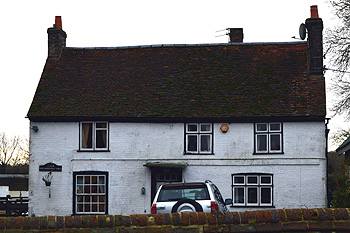Old Greenend Farmhouse Kensworth

Old Greenend Farmhouse January 2013
Old Greenend Farmhouse was listed by English Heritage in January 1992 as Grade II, of special interest. The property is described as “probably” dating from the 16th century, though it was extended in the early 19th century. It is of timber-framed construction, faced in painted brick, the extensions are in brick. It has tiled roofs. The original building was in an L-shape with two rooms on the ground floor. The room on the left-hand side was built in the early 19th century and has a brick inscribed with the date 1827.
The Rating and Valuation Act 1925 specified that every building and piece of land in the country was to be assessed to determine its rateable value. The valuer visited Green End Farm on 14th August 1926 in the morning. The farm was owned and occupied by Walter Dixon. The rent had been £145 per annum from 1900 to 1915 and had risen to £210 until the time Dixon bought it (the date is not stated in the valuation survey). Until the First World War the farm had comprised 140 acres but this had risen to 193 acres by 1926. The valuer commented: “House is in good order, old, but is unoccupied. Lamps. No drinking water … land expensive to work. Buildings poor”. Another hand has written: “House fair. Homestead small. 2 cottages tumbling down”.
The unoccupied Old Greenend Farmhouse comprised two reception rooms, a kitchen, scullery, pantry and cellar with five bedrooms (“3 sloping”) on the first floor. A brick and slate earth closet stood in the garden. The homestead comprised the following:
North Block: a timber and tiled well house; a brick and tiled gig house, tool house and hen house; East Range: a brick and slate pig pen; a two bay open hovel and a calf pen; South Range: a brick and slate cowhouse for four and a large brick, timber and slate barn; Between yards: a large double iron shelter dividing the yards; South Block: a brick, timber and slate stable for six and a chaff place; West Block: four brick, tile and slate pigsties; a brick and corrugated iron mixing house; a brick, timber and tile loose box and “two old cottages that are derelict”; Buildings in the field opposite: a timber and corrugated iron chaff barn; a five bay cart hovel; a large barn was a concrete floor; a wood barn and a five bay implement hovel.
Directories for Bedfordshire were not published every year but every few years from the early to mid 19th century until 1940. Kensworth is first included in Bedfordshire directories in 1898, having been transferred from Hertfordshire in 1897. Green End Farm is listed as farmed by William Barton Stanbridge in 1898, 1903, 1906 and 1910. In 1914 and 1920 the occupier was Mrs. Harriett Stanbridge. Walter Dixon is listed in 1924, 1928 and 1931 and the final two directories for the county, 1936 and 1940 list Nelson Smith Barber.
The 1911 census described William Barton Stanbridge as being 46 years old. He had been born Kensworth and was married to 44 year old Harriett, who had been born in Steppingley. Their children were Bruce John, aged 19 and Olive Mary, aged 18, both of whom had been born in Kensworth. Bedfordshire and Luton Archives and Records Service has farming diaries kept by Bruce Stanbridge for the years 1907 to 1926 with the exception of 1917-1919 and 1925 [X978]. These reveal that William Barton Stanbridge died on 16th February 1912 and was buried in Kensworth churchyard. Harriett survived him by forty four years, dying on 7th October 1954, aged 88; she was also buried at Kensworth. Bruce married Dora Keen in early 1918, she was two years Bruce’s junior. Their daughter Monica was born at the end of the year. Dora died in 1965 and Bruce in 1971. Bruce also took over the tenancy of Church Farm, Studham in 1920 [X978/8] and in 1920 his uncle George “bought Nash Farm [Kensworth] for mother” [X978/9]; Bruce seems to have given Green End Farm up in the same year. Bruce later took on Maylords Farm, Kensworth.